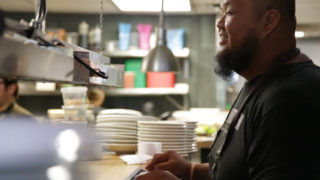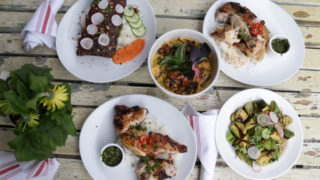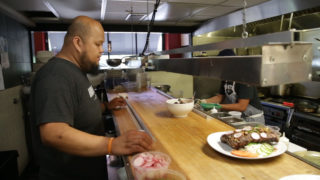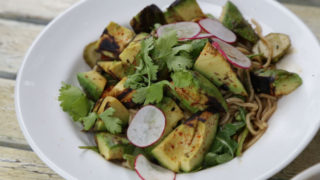By Katie Moritz | Rewire
In elementary school, Chef Yia Vang was embarrassed to talk about what his family ate for dinner.
Born in Thailand, Vang immigrated to the United States with his family from a refugee camp when he was 4 or 5. Once he started school, he said, he wished his lunches in the cafeteria and dinners at home were more like what he saw his classmates eating.
“When (I was) in elementary school and people were like, ‘What’d you have for dinner last night?’ You didn’t want to be like, ‘Ah, we had, like, fish head soup,’” he said.
When we were growing up, all I ever wanted to eat was normal American food. Like Lunchables were my thing. My mom and dad never packed Lunchables for us. But I would watch my friends eat Lunchables, and I remember telling myself, ‘One day when I grow up, when I’m an adult and I have my own money, I’m going to buy Lunchables.’”
Today, this memory makes Vang laugh. He’s now a cook and the co-owner of a pop-up restaurant, Union Kitchen, that celebrates the food and traditions of his Hmong culture. The Hmong are an ethnic group native to Thailand, Laos, Vietnam, Myanmar and China. Hmong people began immigrating to the United States after the Vietnam War.

Vang wants to honor the food he grew up eating. But, rather than putting only traditional Hmong food on his menu, each dish is inspired by the story of the Hmong people.
“We want to elevate Hmong food, and not in the way of, like, ‘We’re going to be plating with Tweezers, and it’s going to be $35 dishes.’ That’s not what we mean,” Vang said. “We want to elevate… Hmong food because we want to show people the richness in our culture through our food.
I want Hmong food to be part of normal conversation, you know. It’s like anybody saying, ‘Hey, let’s go grab burgers tonight’ — ‘Hey, let’s go to Union Kitchen and… get some sticky rice.’ Here, in the Twin Cities, we live in this amazing hub of different cultures. If you want to stick to your normal food, I guess, sure. … But, literally, a stone’s throw away, are different worlds.”
Food is often the perfect entry point into an unfamiliar culture. Vang hopes Union Kitchen can close the gap for people who aren’t accustomed to Hmong dishes while honoring the culture they belong to.
“I always say, ‘You cook from who you are,’” Vang said. “So I’m not gonna try to start a French bistro. I’m not doing Spanish Tapas. We’re not doing Mexican street food. We are certainly influenced by (those), but the question I always get is, “What kind of food do you guys do?” We always say, “We do Hmong food.” And then the next question we always get is, ‘Well what is Hmong food?’”
Vang talked with Rewire about his take on Hmong tradition and what it’s really like to start a pop-up business.
Rewire: A lot of thought goes into Union Kitchen’s menu. You craft a narrative for each dish you serve. Why is that important?
Yia Vang: Union Kitchen started with food plus community. As you get into the community aspect you find out that there are stories about people, and some of them will revolve around food … It starts at food, but it doesn’t end at food. Every dish has a narrative, and if you follow that narrative close enough and long enough you get to the people behind the dish. I started looking into the narratives of the dishes that we started cooking and why I cook them, it really led me back to my childhood kitchen. It led me back to watching my mom do things.

I remember at 6, 7 years old, I hated going out to the garden… on Saturday morning. While most kids watched cartoons we went out to the garden, and I hated that. But now I would give anything to be back there, to see the techniques that my mom uses in the garden. That’s the story that comes by with all the dishes we do.
Our menus are pretty small. It’s like a six, seven item menu, and every menu has a narrative, has a story. We collaborate with different people that come in to cook with us, different chefs or just people that are cooks with us, and it’s part of their story. I think one of the cool things that I tell especially the young Hmong kids that come cook for us, I always say that the trajectory of our culture, or where our culture goes will be determined by the food you cook in the kitchen.
As I talk to these young Hmong guys who are cooking, and they’re trying to find their own identity and their own voice in cooking, I tell them, “This is your story. This is your contribution to your people. Twenty-five years from now you want to see the trajectory of your culture, this is where it is. This is where it starts, because food is so central to our families. Food is so central to who we are.”
Rewire: What does cooking traditional Hmong food mean to you?
YV: The question I always get is, “What kind of food do you guys do?” And we always say, “We do Hmong food.” And then the next question we always get is, “Well what is Hmong food?”
And so I started breaking down the foods that we ate and why we ate them. A lot of it is… very brothy, it’s very soupy. You didn’t get nice big chunks of rib eye meats or whatever. It was all bones. And it really showed that my people in Laos living in the hills of Laos and living in Thailand, they didn’t have much but they were able to scrape by. And not even scrape by, I shouldn’t even say that. It’s like the hustle. They were able to go out to a piece of land that wasn’t fertile and they went and they grew beautiful gardens out there.
So wherever they’ve been to, the Hmong people, wherever they’ve been to they’ve taken a little piece of that culture and a little piece of the techniques they use and they forged it into their own culture and their technique. So, that’s what we would say. We’re unapologetic about the fact that we make Hmong food. Some of the older generation, I think they wouldn’t see it as that, they would just be like (we’re) kind of messing with our tradition.
Rewire: Do you get critiques from the older generation on authenticity?

YV: I always get nervous cooking for the older generation. I always get a little nervous cooking for them ’cause I’m like, “Uh. I don’t know what they’re gonna say.” But one of the most beautiful things that we’ve done is we make (these) braised pork ribs with mustard greens. But instead of just throwing the pork ribs and mustard greens in water and letting it cook, as most traditional Hmong household will have, what we did was we basically made a really nice fortified stock. So it was almost like a tonkotsu ramen stock. And then we roasted the ribs off and… we did this braised mustard green.
And I had a friend who’d eat it and he goes like, “Man, if I close my eyes I cannot tell the difference between this and my grandma’s.” And I was just like, “Wow!” I thought I was trying to do something new but it actually reversed back to reminding him of his grandma’s braised pork ribs with mustard green. And so, that was something that was very interesting to me.
Rewire: Some of the workers in your kitchen aren’t professionals, but people who love to cook and want to learn. Why is that part of Union Kitchen’s business model?
Yia Vang: In Union Kitchen we have three convictions, and I say we cook, we teach, we host. The teaching element is very important to us. As we teach the diners about the food we make, … the beautiful thing that we’ve been able to do is just teach people who are like, I think, weekend warriors… but then being able to slowly explain to them this is how it works in the kitchen.
I think one of the most beautiful moments I had was a friend of mine, she came and she was a server for us, and she’s a piano teacher, actually, by trade. She came and after she got done working a full shift of serving, she’s like, “Yeah, when I go out to eat I will tip my servers more.” She’s like, “I did not know what it takes to be a server.” It’s so cool to see, for people to see through that lens of the service industry, and it’s just been a fun, fun thing.
I’ve really been very blessed to have people constantly call and say, “Hey, do you mind if I come and cook? I’m not really that good, but I would love a chance to.” That’s been really fun, and that teaching element, I think, makes us different and makes us special.
Rewire: What’s it like to start pop-up restaurant?
YV: At my heart, my soul, I’m a line cook; I cook and that’s what I do. And you’re behind basically kinda closed doors, nobody really sees what you do and there’s a passion with that. But the moment you kinda start going towards kinda doing a pop-up, I had to wear different hats. So I was no longer just back of the house. I was front of the house too. I was managing. If somebody who said, “Hey, we’re gonna come and help.” But then he doesn’t show up you gotta figure out what to do for that.

Everyone always thinks that pop-ups are really cool and sexy. They’re not, because you have all your stuff spread out everywhere. We have some storage stuff at a friend’s restaurant. And there’s storage stuff at my brother’s garage. Then when you’re ready for a pop-up you have to drive all around town and grab everything and bring it to your area. So, 80% is just moving stuff. And so that’s what we kinda always joke about with pop-ups. And so it was really hard.
Rewire: How do you deal with criticism, especially in the era of the online review?
YV: When you’re a cook you put a lot of your heart and soul into the food and you put it out there and reviewers, Yelpers, whatever, they can destroy it in like a sentence. We had one where some guys wrote something about like, “Oh, this isn’t how my mom would traditionally make it,” or something. And I remember we had like 20 great compliments but that one thing just kinda stuck in my heart. And learning how to look past that, to know that (I) have this team of incredible friends and family who’s constantly behind us. Different vendors, different restaurants. Even different restaurants that say, “Hey, we believe in you. That’s why we’re gonna let you use our space.”
At the end of the day for (Union Kitchen co-founder Chris Her) and I, we sit down and we’re just like, man, we want to tell a story. And our passion to tell our story through food, it’s what drives us. I think, that’s for me, that’s the biggest thing. Making sure I tell the story right.
Rewire: What would you tell another young person who wants to express their own culture through food?
YV: If there was somebody out there who really wanted to do this, the first thing I would say is go to somebody who’s done it. I always say, go find the guys who are the veterans of life. You can see it in their eyes, where it’s like, they’ve been through a lot. And I say glean from them. Just go and you just stand by them. You say, “Hey, let’s go grab coffee.” That’s the one thing I did, that I was very blessed to do, was I just sat with all these restaurateur guys who struggled the same way that I did, and now they’re doing really well. And they would just talk to me about these processes and these things that, emotionally, my heart’s been kind of going through.
For young guys who want to try this, I tell you, “Go, and glean, and listen. Shut your mouth, sit down, and listen. And listen to the men and women who’ve been through it, and experience it with them.” Say, “Hey, can I come in for a night? I just want to watch. Can I come in for a night? I want to help serve. I want to chop something.”
I think that’s the first thing you start out with, and you’ll find out if you’re up for it or not.
![]() This article originally appeared on Rewire
This article originally appeared on Rewire
© Twin Cities Public Television - 2017. All rights reserved.
Read Next



